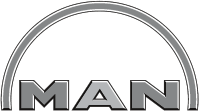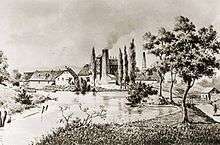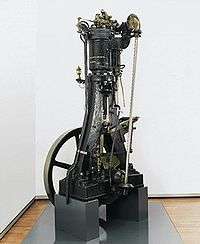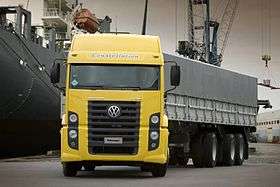MAN SE
MAN SE (abbreviation of Maschinenfabrik Augsburg-Nürnberg, German: [maˈʃiːnənfaˌbʁiːk ˈʔaʊksbʊʁk ˈnʏʁnbɛʁk, -faˌbʁɪk-]), formerly MAN AG, is based in Munich, Germany. Its primary output is commercial vehicles and diesel engines through its MAN Truck & Bus and MAN Latin America divisions, and participation in the manufacturer Sinotruk.[5]
 | |
| Societas Europaea | |
| Traded as | FWB: MAN |
| ISIN | DE0005937007 |
| Industry | Manufacturing, automotive industry, marine engineering |
| Predecessor | ERF, Eisengießerei Klett & Comp. |
| Founded | 1758[1] |
| Headquarters | Munich, Germany |
Key people | Joachim Drees (CEO) Andreas Renschler (Chairman of the Supervisory Board) |
| Products | diesel and other engines, turbomachinery |
| Revenue | €13.6 billion (2016)[2] |
Number of employees | 53,824 (end 2016)[3] |
| Parent | Traton SE (94.36%)[4] |
| Website | corporate.man.eu |
MAN SE is majority owned by Traton SE, the heavy commercial vehicle subsidiary of automaker Volkswagen AG.[6].
History
Foundation

MAN traces its origins back to 1758, when the "St. Antony" ironworks commenced operation in Oberhausen, as the first heavy-industry enterprise in the Ruhr region. In 1808, the three ironworks "St. Antony", "Gute Hoffnung" (English: "Good Hope"), and "Neue Essen" (English: "New Forges") merged, to form the Hüttengewerkschaft und Handlung Jacobi (English: "Jacobi Iron And Steel Works Union And Trading Company"), Oberhausen, which was later renamed Gutehoffnungshütte (GHH).[1]
In 1840, the German engineer Ludwig Sander founded in Augsburg the first predecessing enterprise of MAN in Southern Germany: the "Sander'sche Maschinenfabrik." It firstly became the "C. Reichenbach'sche Maschinenfabrik", which was named after the pioneer of printing machines Carl August Reichenbach, and later on the "Maschinenfabrik Augsburg".[1] The branch Süddeutsche Brückenbau A.G. (MAN-Werk Gustavsburg) was founded when the company in 1859 was awarded the contract for the construction of the railway bridge over the Rhine at Mainz.
In 1898, the companies Maschinenbau-AG Nürnberg (founded 1841) and Maschinenfabrik Augsburg AG (founded 1840) merged to form Vereinigte Maschinenfabrik Augsburg und Maschinenbaugesellschaft Nürnberg A.G., Augsburg ("United Machine Works Augsburg and Nuremberg Ltd."). In 1908, the company was renamed Maschinenfabrik Augsburg Nürnberg AG, or in short, M·A·N.
While the focus initially remained on ore mining and iron production in the Ruhr region, mechanical engineering became the dominating branch of business in Augsburg and Nuremberg. Under the direction of Heinrich von Buz, Maschinenfabrik Augsburg grew from a medium-sized business of 400 employees into a major enterprise with a workforce of 12,000 by the year 1913.
Locomotion, propulsion and steel building were the big topics of this phase. The early predecessors of MAN were responsible for numerous technological innovations. The success of the early MAN entrepreneurs and engineers like Heinrich Gottfried Gerber, was based on a great openness towards new technologies. They constructed the Wuppertal monorail ("Wuppertaler Schwebebahn") and the first spectacular steel bridges like the Großhesseloher Brücke in Munich in 1857 and the Müngsten railway bridge between 1893 and 1897.

The invention of the rotary printing press allowed the copious printing of books and newspapers and since 1893, Rudolf Diesel puzzled for four years with future MAN engineers in a laboratory in Augsburg until his first Diesel engine was completed and fully functional.

During 1921, the majority of M.A.N. was taken over by the Gutehoffnungshütte Actienverein für Bergbau und Hüttenbetrieb, Sterkrade (GHH), (founded 1873).[1] Through well-directed equities and acquisitions of processing industries, e.g., Deutsche Werft (1918), Ferrostaal (1921), Deggendorfer Werft und Eisenbau (1924), MAN advanced to a nationwide operating enterprise, with a workforce of 52,000 by 1921. MAN also produced tractors by the name MAN Ackerdiesel between (1938-1962). The decision for tractors production was made due to increasing demand from eastern Germany.
Crisis and World War II
At the same time the GHH's economic situation worsened. The causes for this were, among others, the reparations after World War I, the occupation of the Ruhr region and the world economic crisis. In only two years the number of MAN employees sank from 14,000 in the year 1929/30 to 7,400 in 1931/32. While the civil business was largely collapsing, the military business increased with the armament under the National Socialist regime. GHH/MAN enterprises supplied diesel engines for submarines, tanks (Panzers), cylinders for projectiles and artillery of every description. MAN also produced gun parts, including Mauser Karabiner 98k rifle bolts. Their Waffenamt code was WaA53, and ordnance code was "coc".
The MAN works in Augsburg, which produced diesel engines for U-boats, and the MAN works in Nuremberg, which built 40 percent of Germany's Panther tanks, were often the target of massive Allied bombing attacks during World War II.[1]
Postwar period
After the end of World War II the allies split up the GHH group. A vertical integration in which mining, iron and steel production are consolidated was not allowed any more. The "Gutehoffnungshütte", together with the MAN firms of Southern Germany, therefore concentrated on engineering, plant construction, commercial vehicles and printing machines. This process has been supported by strategic acquisitions and dispositions; one of the most important was the take-over of the truck and bus division of the commercial vehicles manufacturer Büssing (1971), the disposition of the shares of the shipyard Deutsche Werft (1966/67) and the acquisition of the printing machine producer Faber&Schleicher as well as its fusion to MAN Roland Druckmaschinen AG (1979).[1]
In 1982/83 the "Gutehoffnungshütte" plunged into a deep corporate crisis. The enterprise suffered from the late effects of the second oil crisis and a bad economic situation. This was particularly displayed by the dramatic downturn of the commercial vehicles sales figures. Besides external factors, the chief course of these problems was the obsolete company structure with extensive cross-subsidisation between the divisions. At this time the former director of GHH presented a reclamation concept that envisioned a complete consolidation of the subsidiary with the holding company. This concept encountered great resistance with GHH's major shareholders Allianz AG and Commerzbank. The media speculated about a "Bavarian conspiracy" against the Management in Oberhausen.[1]
In 1986, with Klaus Götte, the group got a new company structure and became a contractual group with economically independent division at several locations. This was also attended by the transferring of the MAN headquarters from Oberhausen to Munich and by the new company name MAN AG.
Rudolf Rupprecht repelled a takeover attempt in 2003. Furthermore, the disposition of the 50-percent share of the SMS Group and the strengthening of the turbomachinery division through the takeover of Sulzer Turbo induced MAN's focusing process.
In 2006, MAN entered into an agreement with Indian company Force Motors to establish a 50:50 joint venture for the production of trucks and buses in India for the domestic and export markets. The joint-venture established a truck manufacturing plant in Pithampur, Madhya Pradesh and launched its first truck for the Indian market in 2007. At the end of 2011, MAN bought out the stake of its Indian partner, and its operations in India became a wholly owned subsidiary of MAN in early 2012.[7][8]
In September 2006, MAN produced an offer for the take-over of the Swedish competitor Scania AB. The European Commission approved the takeover on 14 December. Nevertheless, MAN voluntarily withdrew the offer on 23 January 2007, after Scania's major shareholders Volkswagen AG and the influential Wallenberg family had declined the offer. On 24 December 2008, MAN published to possess further stock options of Scania and to therefore maintain more than 20 percent of the voting rights. As of October 2019, MAN SE still owns 17.37% of the voting rights in Scania, with the remainder of Scania being directly owned by Volkswagen Group's heavy commercial vehicle subsidiary, TRATON SE. [9]
.jpg)
In 2008, the MAN group celebrated its 250th anniversary with numerous events, like exhibitions in several museums, a vintage car tour with the motto "MAN on the road again" and a great anniversary gala. At the beginning of December 2008 MAN took over Volkswagen's Brazilian truck and bus operation, Volkswagen Caminhões e Ônibus, putting the division under the control of MAN Latin America. Therewith, MAN now is market leader in Brazil, with a market share of 30 percent.
Since May 2009, the group is incorporated as European corporation MAN SE.[10] In July 2009 MAN published to merge the two divisions MAN Turbo and MAN Diesel into one business area called Power Engineering. In addition the group contracted a strategic partnership with the Chinese truck manufacturer Sinotruk, purchasing 25% + 1 share of the company. In the course of this focusing process, many smaller subsidiaries and divisions have been sold.
In 2009, investigators of the Munich Prosecutor's Office uncovered a corruption affair, in which MAN had been bribing business partners and governments in over 20 countries during the years 2001 to 2007, in order to get large orders for buses and trucks. MAN CEO Håkan Samuelsson and further board members had to resign. The board of directors appointed Dr.-Ing. Georg Pachta-Reyhofen, the former CEO of MAN Diesel, as successor. On 17 December 2009 Pachta-Reyhofen was assigned as speaker of the board and CEO of MAN SE by the board of directors.

Takeover by Volkswagen
In July 2011, Volkswagen AG acquired a 55.9% voting stake and 53.7% of the share capital in MAN SE. Pending regulatory approval, Volkswagen planned to merge MAN and Scania to create Europe's largest truckmaker. The combined trucks group is planned to save about 400 million euros per year, mainly by bundling procurement.[11][12] Regulatory approval was granted, and the takeover completed, in November 2011.[13]
In April 2012 MAN SE announced that Volkswagen had increased its interest to a 73.0% voting stake and 71.08% of the share capital.[14]
On 6 June 2012 Volkswagen AG announced that it had increased its share of voting rights in MAN SE to 75.03%, paving the way for a domination agreement to be put in place.[15]
From January 2019, MAN's Power Engineering division, made up of MAN Energy Solutions (formerly MAN Diesel & Turbo) and MAN SE's 76% stake in RENK AG were sold to the Volkswagen Group, leaving MAN SE as the holding company for commercial vehicle units, MAN Truck & Bus, and MAN Latin America, under the responsibility of Volkswagen's subsidiary TRATON SE.
In March 2019, MAN SE announced that 94.36% of its shares were held by TRATON.
In February 2020, TRATON announced that it intends to merge MAN SE with TRATON in order to simplify TRATON’s overall structure. As a result of the merger, MAN Truck & Bus SE, Scania AB and Volkswagen Caminhões e Ônibus will become wholly owned direct subsidiaries of TRATON.[16]
Legal Issues
In 2011, a former manager in the company was charged with bribery of Turkmen state officials exchange for project contracts in 2002. The trial began in Munich in 2019 after a delay of the initial trial set for 2016.[17][18] The MAN manager was suspected in giving 8.4 million euros bribe in 2002-2007 to the head of the state-owned Turkmennebit company, Saparmammet Veliev.
References
- "MAN SE - The MAN Group's History - Industrial Pioneering". MAN SE. MAN.de. Retrieved 23 November 2009.
- "Annual Report 2010" (PDF). MAN Group. Archived from the original (PDF) on 12 August 2011. Retrieved 3 April 2011.
- "MAN SE Annual Report 2013" (PDF). Man Group. April 2013. Retrieved 28 April 2015.
- http://www.4-traders.com/MAN-SE-436151/company/. Retrieved 25 October 2016. Missing or empty
|title=(help) - "MAN Global Corporate Website". www.man.eu. MAN SE. 12 January 2014. Retrieved 12 January 2014.
- MAN AG Annual Report 2016. MAN AG. 2016. p. https://www.corporate.man.eu/man/media/en/content_medien/doc/global_corporate_website_1/investor_relations_1/gb/2016_40/GB2016_DEU_geschutzt.pdf.
- "Annual Press Conference - February 14, 2012" (PDF). MAN SE. Retrieved 22 February 2012.
- "Ten years of MAN Truck & Bus in India". PressCenter. MAN SE. 16 September 2016. Archived from the original on 17 October 2016.
- "MAN SE Company Presentation" (PDF). MAN SE. October 2019.
- "MAN becomes a European stock corporation". www.man.eu. MAN SE. 26 May 2009. Archived from the original on 20 July 2011. Retrieved 17 December 2009.
- "VW motors ahead with MAN-Scania truck merger plan". Reuters. 31 May 2011. Retrieved 16 August 2011.
- "VW Moves on Trucks". Wall Street Journal. 5 July 2011. Retrieved 16 August 2011.
- "VW Claims Victory". Commercial Motor. 27 November 2011. Retrieved 28 November 2011.
- "Volkswagen hikes majority stake in truckmaker MAN". 13 April 2012. Retrieved 10 May 2012.
- "Volkswagen Group increases its share of voting rights in MAN SE to 75.03 percent". 6 June 2012. Retrieved 6 June 2012.
- "TRATON seeking to execute a squeeze-out of the non-controlling shareholders of MAN SE in accordance with merger law". 28 February 2020. Retrieved 14 March 2020.
- RFE/RL's Turkmen Service (11 December 2019). "Former German Manager On Trial For Bribing Of Turkmen Oil Officials". Radio Free Europe / Radio Liberty. Retrieved 12 December 2019.
- "GIR Search - GIR - Global Investigations Review". globalinvestigationsreview.com. Retrieved 15 July 2020.
